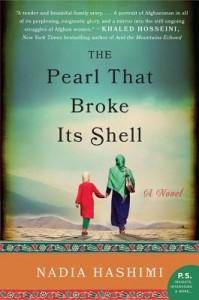Title: The Pearl That Broke Its Shell
Author: Nadia Hashimi
ISBN: 9780062244758
No. of Pages: 464
Genre: Fiction
Origins: William Morrow and Company
Release Date: 6 May 2014
Bottom Line: Tough, tough subject matter but well-written and eye-opening
 Synopsis:
Synopsis:
“In Kabul, 2007, with a drug-addicted father and no brothers, Rahima and her sisters can only sporadically attend school, and can rarely leave the house. Their only hope lies in the ancient custom of bacha posh, which allows young Rahima to dress and be treated as a boy until she is of marriageable age. As a son, she can attend school, go to the market, and chaperone her older sisters.
But Rahima is not the first in her family to adopt this unusual custom. A century earlier, her great-great grandmother, Shekiba, left orphaned by an epidemic, saved herself and built a new life the same way.
Crisscrossing in time, The Pearl That Broke Its Shell interweaves the tales of these two women separated by a century who share similar destinies. But what will happen once Rahima is of marriageable age? Will Shekiba always live as a man? And if Rahima cannot adapt to life as a bride, how will she survive?”
Thoughts: The tradition of being a bacha posh is fascinating, and Ms. Hashimi does an excellent job of emphasizing the issues with “switching” genders. The reasons for becoming a bacha posh only serve to emphasize the gender disparities, and it is no wonder that the girls have such a difficult job identifying as women and adjusting to their new subservient roles. In fact, one could argue that the very freedoms they enjoyed when they were considered men doomed them from ever being very happy as a grown woman because there is no such thing as gender parity in their world.
This idea of being able to switch genders leads to a myriad of questions of gender identity in other cultures. In Afghanistan, apparently girls can become boys by nothing more than cutting their hair and donning a pair of pants. Even the terminology is curious, as the girls have to “switch back” to being females. It really begs for more research into the sociology and psychology behind this tradition, how it started, and even how it does not raise greater discussion for its ongoing adoption.
While Rahima and Shekiba’s stories end on a hopeful note, the rest of their story is rather bleak. Rahima and Shekiba have absolutely no say in what happens to them. Physical abuse is an every day part of their lives in addition to mental and emotional abuse. They are little more than slaves in the eyes of their family members. It is as upsetting a glimpse into someone else’s life as one can get.
The Pearl That Broke Its Shell is a powerful story about making one’s own destiny. It is the type of novel that lends itself well to discussion as it raises so many questions about Sharia law, cultural differences, gender disparity, and others. It also allows American readers the chance to catch a rare glimpse of life inside the Afghanistan borders from an Afghan point of view. The scenes of violence and abuse are stomach-churning, but it only makes them more important specifically because they are difficult to read. Ms. Hashimi never pontificates. Instead, she lets the girls tell their own stories. As such, there is a matter-of-factness to everything that serves to confirm the truth behind their experiences; all judgment is left for readers to make. Challenging novels tend to be the most important ones to read in order to grow in empathy and understanding, and The Pearl That Broke Its Shell is most definitely a challenging novel.
